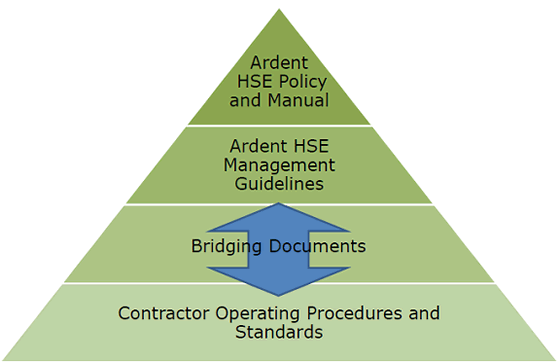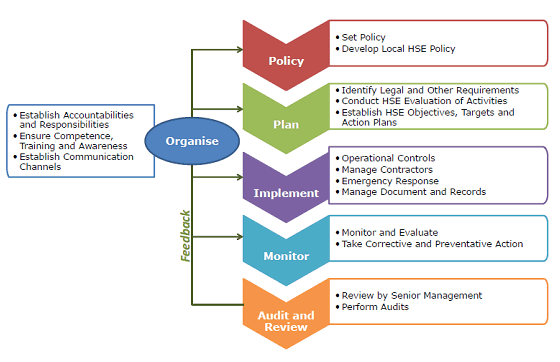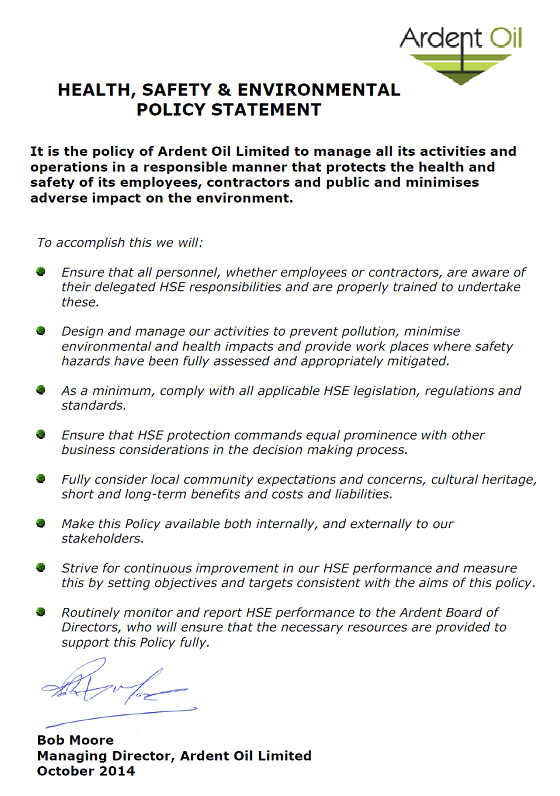Responsibilities
Overall responsibility and accountability for the HSE Policy and its implementation lies with the Ardent Managing Director. Day-to-day operations will be managed by the Exploration Manager and he has the responsibility and financial authority to ensure the HSE Policy and Management System is implemented and acted on in the event of an incident or emergency during operations.
All employees, consultants and contractors are required to familiarise themselves with legislative and Company requirements applicable to their functions, and with the particular risks and environmental sensitivities of the area or areas in which the Company is conducting its operations.
It is the intention of Ardent to maintain only a small core of direct managerial and administrative company employees and to outsource to qualified consulting companies most of the required specialist, technical and operating skills and expertise.
The Company will employ an HSE Advisor who will report directly to the Exploration Manager. It is anticipated this will initially be on a part time consultancy basis. The duty of the HSE Advisor will be to monitor compliance with Regulations and the Company Management System and to advise the Exploration Manager on HSE issues.
HSE
Ardent is currently developing an HSE Management System (HSE MS). This will be developed to comply with international (e.g. ISO14001/18001) standards.
The Ardent HSE MS documentation hierarchy is shown in Figure 2. The driver of the system is the HSE Policy and Manual, together with its associated Management Guidelines. At the base of the hierarchy are the contractors' standards and procedures, which will be linked to Ardent's Management Guidelines via the Management Interface Documentation (e.g. Bridging Documents) which defines responsibilities between the operator, its partners and contractors. Reviews of contractor's management systems will be undertaken as part of the contractor selection process to ensure consistency with Ardent expectations.

Figure 2. Hierarchical Structure of Ardent HSE MS Documentation
The HSE Management System framework is illustrated in Figure 3. The system describes how all the HSE activities within the business are organised and how it applies throughout the business lifecycle. The impetus to drive and maintain the system is provided by the organisation which sets the HSE policy and determines the overall performance standards. The process of applying these standards to each activity within the business starts with an assessment to identify possible hazards, assess the risks and agree sensible controls that will minimise any consequences and reduce risks to levels that are as low as reasonably practicable (ALARP). These measures are then incorporated into resourced work plans which are then implemented. The whole process is routinely monitored, reviewed and audited to determine overall performance and identify areas where improvements would be worthwhile.

Figure 3. Ardent HSE MS Framework
The system is currently in development and although it is being produced to be consistent with ISO 14001 and OSHA 18001 there is no intention to seek certification at this time. Ardent is aware of the OSPAR Recommendation 2003/5 to promote the use and implementation of environmental management systems by the offshore industry. Once the HSE MS has been completed, and prior to commencing the planning of any offshore operations, it is the Company's intention to seek 3rd party verification of compliance with the legislative requirements on environmental reporting and measurement methods. Following commencement of qualifying activities, Ardent will prepare an annual environmental report and make it available to the public.
In summary, for exploration activities, the HSE MS will provide the overall framework within which all activities will be managed. Operations will be conducted within the management systems of contractors with bridging documents to define the interfaces between the two systems.
Ardent's HSE Policy is provided in Figure 4. The HSE Policy is implemented through the HSE MS and associated guidance documentation. The policy is communicated throughout the company on notice boards. It is communicated externally as part of all HSE documentation (e.g. Bridging Documents, Environmental Statements, Oil Spill Contingency Plans) and is provided to contractors during the tendering process to ensure all work, services and equipment meets the policy and relevant standards.
The HSE Policy has only been recently reviewed and updated and will continue to be reviewed regularly.
Reviews take into account:
- the results of audits;
- comments made by staff, contractors and external organisations;
- changes in activities, requirements or legislation; and
- continued applicability and function of the policy and system

Figure 4. Ardent Health Safety and Environmental (HSE) Policy
The contents of the HSE Management System Framework Manual will follow the layout provided below. The HSE MS will apply to all of Ardent's operations.
Contents of HSE MS Framework Manual:
1. Introduction
- Purpose
- Scope
- Key Steps
- HSE Policy
2. Assessment
- Risk Management
3. Plan and Resource
- Planning
- Emergency Response
- Leadership
- Competence and Training
4. Implement
- Contractor Management
- Management of Change
- Incident and Non-Conformance Reporting and Investigation
5. Monitor
- Monitoring and Evaluation
- Corrective and Preventive Action
6. Audit and Review
Guidance Documentation:
- Competence Assurance and Training
- Risk Management
- Contractor Selection and Management
- Emergency Response
- Incident Reporting and Investigation
- Audit and Review
- HSE Plans
- Management of Change
- Regulatory Compliance
- Document Control
Training plans and programmes are currently being developed and necessary training will be implemented prior to any operations. Specific programmes planned include:
- HSE Awareness
- HSE MS Roll Out
- Emergency Response Training (including oil spills)
- Emergency Response Exercises
Full emergency response exercises (including oil spill) will be held prior to all operations. These exercises will include contractors and relevant external organisations such as the coastguard, police and the Danish Authorities.
Management processes to control potential HSE risks and impacts are defined within the HSE MS. Specific relevant examples include:
Risk Management (Guideline 2) - The Risk Management guideline outlines the requirements for the identification and assessment of environmental hazards, selection and implementation of control measures and the development of appropriate monitoring programmes to ensure the effectiveness of control measures. The environmental risk assessment is documented in an Environmental Impact Assessment (EIA) or other appropriate environmental permit requirement.
Regulatory Compliance (Guidance 9) - Ardent is aware of the key relevant environmental regulations pertaining to oil and gas exploration and production in Denmark. The Exploration Manager is responsible for ensuring Ardent is compliant with legislation. The HSE Advisor is responsible for preparing a Legislation Register covering all potential activities. This will be updated using commercially available update services and liaison with the Danish Regulatory Authorities. Project specific legislation registers will be prepared as part of the project HSE Plan (see below).
Contractor Selection and Management (Guidance 3) - Ardent recognises the importance of contractor selection and management in running the business, meeting the HSE policy and achieving its goals and objectives. A strict Contractor Selection and Management procedure is being developed which will define the requirements for selecting, managing and monitoring the performance of all contractors. Contractor selection will include a review of contractor HSE performance at a level relevant to the risks associated with the contract.
HSE Plan (Guidance 7) - A project HSE Plan will be prepared for each project. The plan will include:
- An overview of the work programme;
- A project specific legislation register;
- Any project specific requirements for application of the HSE MS;
- Commitments made in Permits and Consents (e.g. EIAs);
- Regulatory and Company Standards;
- Specific HSE Objectives, Targets and Performance Indicators;
- Monitoring Plan (including contractor performance);
- Audit Plan.
At this stage of operations, HSE objectives, targets and performance indicators, will be developed on a project specific basis. Some of the factors on which these will be set include:
- HSE hazards identified as part of a risk assessment;
- Regulatory requirements
- Best industry practice
- Checks and balances developed to ensure effective implementation of the HSE MS
The basis of the Ardent emergency response and preparedness program is to take all reasonable measures to:
- Ensure that properly trained and equipped personnel are in place to respond to emergency situations that may occur;
- Manage available resources and personnel to minimize injury and damage to property and the environment; and,
- Promote a controlled and effective return to normal operations following an emergency.
PROCESS
A systematic review and analysis driven by risk assessment will be conducted to identify foreseeable emergency response scenarios and evaluate their potential impact on people, the environment, the assets and the business and establish appropriate procedures for preventing, and mitigating the impacts that may be associated with them.
This analysis will review the threats posed by any HS&E incidents and will identify and prioritise critical business processes.
Measures will be identified, documented in plans and implemented to respond to and recover from these identified incidents. Where relevant, performance standards will be established and routinely verified for the response and recovery measures. Depending on risk, such measures will address some or all of:
- Emergency Response Plans to mitigate the operational impact on operations, personnel and the environment of any of the HS&E threats defined above;
- Oil Pollution Emergency Plans (in accordance with the International Convention on Oil Pollution Preparedness, Response and Co-operation, OPRC, and the Danish National Contingency Plan) to specifically mitigate the impact of oil spills on the environment and to manage the clean up of any such spills. Such plans require specialist input and are invariably site and process specific; and
- Medivac Plans to assure that all foreseeable medical emergencies can be in effectively treated.
Such Emergency Response and Evacuation Plans will always be developed in consultation with appropriate employees, external agencies, the public, contractors and support services.
Consultation and advice will be sought from relevant external bodies such as the police, hospitals, local authorities, etc. Consultation and agreement shall be reached with contractors, third parties and others whose assistance may be required during an emergency, e.g. other offshore installation owners, marine and aircraft contractors, etc.
The Emergency Plans will be communicated in an appropriate format to relevant employees, contractors, visitors, external agencies, and members of the public.
All personnel who have command responsibilities, or who have been allocated emergency duties will be competent to carry out those duties. Competency can be gained through induction, experience and knowledge and may be backed up by practice exercises.
All employees, contractors and visitors need to be familiar with their individual roles and responsibilities, shall receive appropriate training and instruction on the actions to be taken in the event of an emergency and will be required to attend crisis and emergency management related training, including refresher courses as needed.
Emergency Response Plans, including Oil Pollution Emergency Plans will be tested at appropriate intervals through the conduct of scenario drills and exercises and other suitable means. The frequency of drills will depend on operational activity.